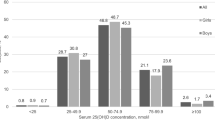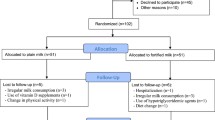Abstract
Summary
The mean serum 25-OH-D was 23.1 ng/mL in 49 female Japanese college students, and concentrations in 33 % of them were ≤20 ng/mL. Subsequently, they consumed milk fortified with 2 μg of vitamin D daily for 8 weeks. Then, 25-OH-D increased to 36.0 ng/mL and all values were ≥20 ng/mL.
Purpose
Commercial milk in the USA is fortified with vitamin D (VD), whereas food fortified with VD is unpopular in Japan even though dietary sources of this vitamin are limited. Therefore, young Japanese females might be VD deficient. This study assesses the effects of ingesting milk fortified with VD among Japanese female college students.
Methods
Forty-nine female college students consumed 180 mL of milk fortified with 2 μg of VD daily for 8 weeks. This amount of VD in the milk was similar to that in commercial milk sold in the USA. Serum concentrations of 25-OH-D were measured in venous blood collected before and after the ingestion period.
Results
The initial serum 25-OH-D concentration was 23.1 ng/mL and concentrations in 33 % of the participants were ≤20 ng/mL. After 8 weeks, serum 25-OH-D increased to 36.0 ng/mL and all values were ≥20 ng/mL. Serum Ca and FGF-23 also increased and PTH, NTX, and BAP significantly decreased.
Conclusions
The high prevalence of VD deficiency in Japanese female college students was decreased by consuming VD-fortified milk.




Similar content being viewed by others
References
Bentley J (2013) Vitamin D deficiency: identifying gaps in the evidence base. Nurs Stand 27:35–41. doi:10.7748/ns2013.07.27.46.35.e7388
Nakamura K, Nashimoto M, Tsuchiya Y, Obata A, Miyanishi K, Yamamoto M (2001) Vitamin D insufficiency in Japanese female college students: a preliminary report. Int J Vitam Nutr Res 71:302–305
Nakamura K, Nashimoto M, Matsuyama S, Yamamoto M (2001) Low serum concentrations of 25-hydroxyvitamin D in young adult Japanese women: a cross sectional study. Nutrition 17:921–925
Tsugawa N, Okano T (2009) Vitamin D and osteoporosis. Vitamins 83:651–658 (in Japanese)
Institute of Medicine (US) Committee to Review Dietary Reference Intakes for Vitamin D and Calcium, Ross AC, Taylor CL, Yaktine AL, Del Valle HB (eds) (2011) Dietary reference intakes for calcium and Vitamin D. National Academies Press (US), Washington DC
Tanaka K, Terao J, Shidoji Y, Tamai H, Imai E, Okano T (2013) Dietary reference intakes for Japanese 2010: fat-soluble vitamins. J Nutr Sci Vitaminol 59:S57–S66
Japanese Ministry of Agriculture, Forestry and Fisheries (2012) Fisheries of Japan-FY2011 (2011/2012) Fisheries policy outline for FY2012 (White Paper on Fisheries: Summary) p.12, http://www.maff.go.jp/e/
Patterson KY, Phillips KM, Horst RL, Byrdwell WC, Exler J, Lemar LE, Holden JM (2010) Vitamin D content and variability in fluid milks from a US Department of Agriculture nationwide sampling to update values in the National Nutrient Database for Standard Reference. J Dairy Sci 93:5082–5090
Kobayashi S, Honda S, Murakami K, Sasaki S, Okubo H, Hirota N, Notsu A, Fukui M, Date C (2011) Both comprehensive and brief-type self-administered diet history questionnaires have reasonable ranking ability for nutrient intakes compared with 16-day dietary records in Japanese adults. J Epidemiol 22:151–159
Sasaki S, Katagiri A, Tsuji T, Shimoda T, Amano K (2003) Self-reported rate of eating correlates with body mass index in 18-y-old Japanese women. Int J Obes Relat Metab Disord 27:1405–1410
Natoinal Institute of Health and Nutrition (2007) Outline of the National Health and Nutrition Survey Japan. http://www0.nih.go.jp/eiken/english/research/pdf/nhns2007.pdf
Ohta H, Kuroda T, Onoe Y, Orito S, Ohara M, Kume M, Harada A, Tsugawa N, Okano T, Sasaki S (2009) The impact of lifestyle factors on serum 25-hydroxyvitamin D levels: a cross-sectional study in Japanese women aged 19–25 years. J Bone Miner Metab 27:682–688. doi:10.1007/s00774-009-0095-1
Ono Y, Suzuki A, Kotake M, Zhang X, Nishiwaki-Yasuda K, Ishiwata Y, Imamura S, Nagata M, Takamoto S, Itoh M (2005) Seasonal changes of serum 25-hydroxyvitamin D and intact parathyroid hormone levels in a normal Japanese population. J Bone Miner Metab 23:147–151
Woo J, Lau W, Xu L, Lam CW, Zhao X, Yu W, Xing X, Lau E, Kuhn-Sherlock B, Pocock N, Eastell R (2007) Milk supplementation and bone health in young adult Chinese women. J Womens Health (Larchmt) 16:692–702
Harris RA, Pedersen-White J, Guo DH, Stallmann-Jorgensen IS, Keeton D, Huang Y, Shah Y, Zhu H, Dong Y (2011) Vitamin D3 supplementation for 16 weeks improves flow-mediated dilation in overweight African-American adults. Am J Hypertens 24:557–562. doi:10.1038/ajh.2011.12
Riggs BL, O’Fallon WM, Muhs J, O’Connor MK, Kumar R, Melton LJ 3rd (1998) Long-term effects of calcium supplementation on serum parathyroid hormone level, bone turnover, and bone loss in elderly women. J Bone Miner Res 13:168–174
Uchida S, Taniguchi T, Shimizu T, Kakikawa T, Okuyama K, Okaniwa M, Arizono H, Nagata K, Santora AC, Shiraki M, Fukunaga M, Tomomitsu T, Ohashi Y, Nakamura T (2005) Therapeutic effects of alendronate 35 mg once weekly and 5 mg once daily in Japanese patients with osteoporosis: a double-blind, randomized study. J Bone Miner Metab 23:382–388
Shiraki M, Nakamura T, Fukunaga M, Sone T, Usami A, Inoue T (2012) A multicenter randomized double-masked comparative study of different preparations of alendronate in osteoporosis—monthly (four weeks) intravenous versus once weekly oral administrations. Curr Med Res Opin 28:1357–1367. doi:10.1185/03007995.2012.709838
Fukunaga M, Kushida K, Kishimoto H, Shiraki M, Taketani Y, Minaguchi H, Inoue T, Morita R, Morii H, Yamamoto K, Ohashi Y, Orimo H (2002) Risedronate Phase III Research Group. A comparison of the effect of risedronate and etidronate on lumbar bone mineral density in Japanese patients with osteoporosis: a randomized controlled trial. Osteoporos Int 13:971–979
Kishimoto H, Fukunaga M, Kushida K, Shiraki M, Itabashi A, Nawata H, Nakamura T, Ohta H, Takaoka K, Ohashi Y (2006) Risedronate Phase III Research Group. Efficacy and tolerability of once-weekly administration of 17.5 mg risedronate in Japanese patients with involutional osteoporosis: a comparison with 2.5-mg once-daily dosage regimen. J Bone Miner Metab 24:405–413
Okazaki R, Hagino H, Ito M, Sone T, Nakamura T, Mizunuma H, Fukunaga M, Shiraki M, Nishizawa Y, Ohashi Y, Matsumoto T (2012) Efficacy and safety of monthly oral minodronate in patients with involutional osteoporosis. Osteoporos Int 23:1737–1745. doi:10.1007/s00198-011-1782-z
Morii H, Ohashi Y, Taketani Y, Fukunaga M, Nakamura T, Itabashi A, Sarkar S, Harper K (2003) Effect of raloxifene on bone mineral density and biochemical markers of bone turnover in Japanese postmenopausal women with osteoporosis: results from a randomized placebo-controlled trial. Osteoporos Int 14:793–800
Itabashi A, Yoh K, Chines AA, Miki T, Takada M, Sato H, Gorai I, Sugimoto T, Mizunuma H, Ochi H, Constantine GD, Ohta H (2011) Effects of bazedoxifene on bone mineral density, bone turnover, and safety in postmenopausal Japanese women with osteoporosis. J Bone Miner Res 26:519–529. doi:10.1002/jbmr.252
Nakamura T, Matsumoto T, Sugimoto T, Shiraki M (2012) Dose–response study of denosumab on bone mineral density and bone turnover markers in Japanese postmenopausal women with osteoporosis. Osteoporos Int 23:1131–1140. doi:10.1007/s00198-011-1786-8
Miyauchi A, Matsumoto T, Sugimoto T, Tsujimoto M, Warner MR, Nakamura T (2010) Effects of teriparatide on bone mineral density and bone turnover markers in Japanese subjects with osteoporosis at high risk of fracture in a 24-month clinical study: 12-month, randomized, placebo-controlled, double-blind and 12-month open-label phases. Bone 47:493–502. doi:10.1016/j.bone.2010.05.022
Wesseling-Perry K, Pereira RC, Sahney S, Gales B, Wang HJ, Elashoff R, Jüppner H, Salusky IB (2011) Calcitriol and doxercalciferol are equivalent in controlling bone turnover, suppressing parathyroid hormone, and increasing fibroblast growth factor-23 in secondary hyperparathyroidism. Kidney Int 79:112–119. doi:10.1038/ki.2010.352
Arya V, Bhambri R, Godbole MM, Mithal A (2004) Vitamin D status and its relationship with bone mineral density in healthy Asian Indians. Osteoporos Int 15:56–61
Fraser WD, Milan AM (2013) Vitamin D assays: past and present debates, difficulties, and developments. Calcif Tissue Int 92:118–127. doi:10.1007/s00223-012-9693-3.29
Liu S, Tang W, Zhou J, Stubbs JR, Luo Q, Pi M, Quarles LD (2006) Fibroblast growth factor 23 is a counter-regulatory phosphaturic hormone for vitamin D. J Am Soc Nephrol 17:1305–1315
Acknowledgments
This study was funded partly by the Japan Dairy Association (J-milk). The fortified milk used in this study was a gift from Meiji Co. Ltd. (Tokyo, Japan). Part of this study was presented at a local meeting of the Japanese Society of Physical Fitness and Sports Medicine during March 2014 in Tokyo, Japan.
Conflicts of interest
None.
Author information
Authors and Affiliations
Corresponding author
Rights and permissions
About this article
Cite this article
Suzuki, Y., Maruyama-Nagao, A., Sakuraba, K. et al. Milk fortified with vitamin D could reduce the prevalence of vitamin D deficiency among Japanese female college students. Arch Osteoporos 9, 188 (2014). https://doi.org/10.1007/s11657-014-0188-x
Received:
Accepted:
Published:
DOI: https://doi.org/10.1007/s11657-014-0188-x




